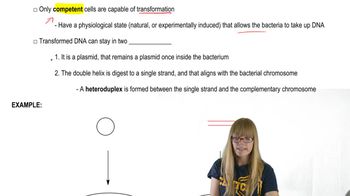When Avery and his colleagues had obtained what was concluded to be the transforming factor from the IIIS virulent cells, they treated the fraction with proteases, RNase, and DNase, followed in each case by the assay for retention or loss of transforming ability. What were the purpose and results of these experiments? What conclusions were drawn?
Table of contents
- 1. Introduction to Genetics51m
- 2. Mendel's Laws of Inheritance3h 37m
- 3. Extensions to Mendelian Inheritance2h 41m
- 4. Genetic Mapping and Linkage2h 28m
- 5. Genetics of Bacteria and Viruses1h 21m
- 6. Chromosomal Variation1h 48m
- 7. DNA and Chromosome Structure56m
- 8. DNA Replication1h 10m
- 9. Mitosis and Meiosis1h 34m
- 10. Transcription1h 0m
- 11. Translation58m
- 12. Gene Regulation in Prokaryotes1h 19m
- 13. Gene Regulation in Eukaryotes44m
- 14. Genetic Control of Development44m
- 15. Genomes and Genomics1h 50m
- 16. Transposable Elements47m
- 17. Mutation, Repair, and Recombination1h 6m
- 18. Molecular Genetic Tools19m
- 19. Cancer Genetics29m
- 20. Quantitative Genetics1h 26m
- 21. Population Genetics50m
- 22. Evolutionary Genetics29m
7. DNA and Chromosome Structure
DNA as the Genetic Material
Problem 8
Textbook Question
What observations are consistent with the conclusion that DNA serves as the genetic material in eukaryotes? List and discuss them.
 Verified step by step guidance
Verified step by step guidance1
Step 1: Understand the historical context by recognizing that early experiments aimed to identify the molecule responsible for heredity, distinguishing DNA from proteins as the genetic material.
Step 2: Discuss the Avery-MacLeod-McCarty experiment, which showed that purified DNA from a virulent bacterial strain could transform a non-virulent strain, indicating DNA carries genetic information.
Step 3: Explain the Hershey-Chase experiment, where bacteriophages labeled with radioactive DNA and protein demonstrated that DNA, not protein, enters bacterial cells and directs viral replication.
Step 4: Describe observations in eukaryotes such as the correlation between DNA content and chromosome number, and the localization of DNA in the nucleus where genetic information is stored and transmitted.
Step 5: Highlight molecular evidence including the structure of DNA (double helix) and its ability to replicate accurately, supporting its role as the stable carrier of genetic information in eukaryotic cells.
 Verified video answer for a similar problem:
Verified video answer for a similar problem:This video solution was recommended by our tutors as helpful for the problem above
Video duration:
2mPlay a video:
Was this helpful?
Key Concepts
Here are the essential concepts you must grasp in order to answer the question correctly.
Griffith's Transformation Experiment
This experiment demonstrated that a 'transforming principle' from dead virulent bacteria could genetically alter live non-virulent bacteria, suggesting the presence of a hereditary molecule. It laid the groundwork for identifying DNA as the genetic material.
Recommended video:
Guided course

Transformation
Avery-MacLeod-McCarty Experiment
Building on Griffith's work, this experiment showed that DNA, not protein or RNA, was responsible for transformation in bacteria. By isolating DNA and demonstrating its ability to transfer genetic information, it provided strong evidence that DNA is the genetic material.
Recommended video:
Guided course

Mendel's Experiments
Hershey-Chase Experiment
Using bacteriophages labeled with radioactive isotopes, this experiment showed that DNA, not protein, enters bacterial cells during infection and directs viral replication. This confirmed DNA as the genetic material in viruses, supporting its role in eukaryotes as well.
Recommended video:
Guided course

Mendel's Experiments

 9:32m
9:32mWatch next
Master History and Experiments with a bite sized video explanation from Kylia
Start learningRelated Videos
Related Practice
Textbook Question
691
views
